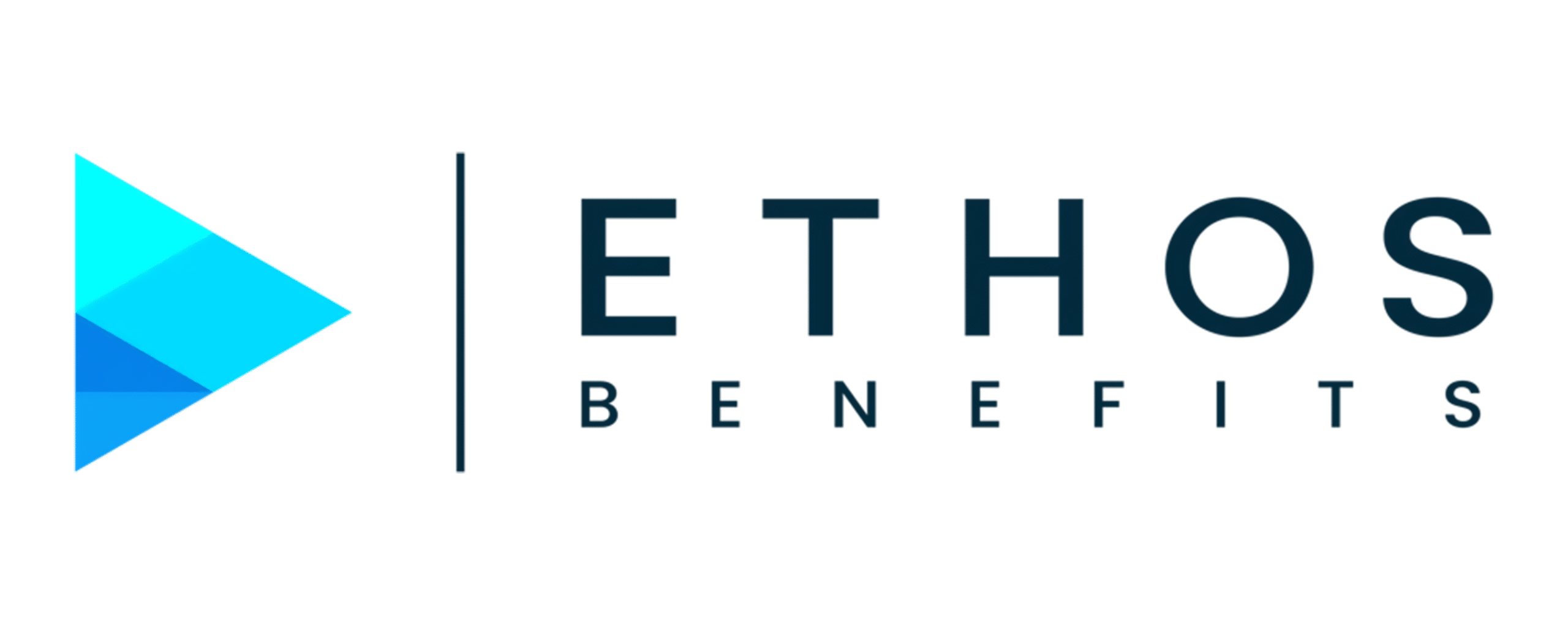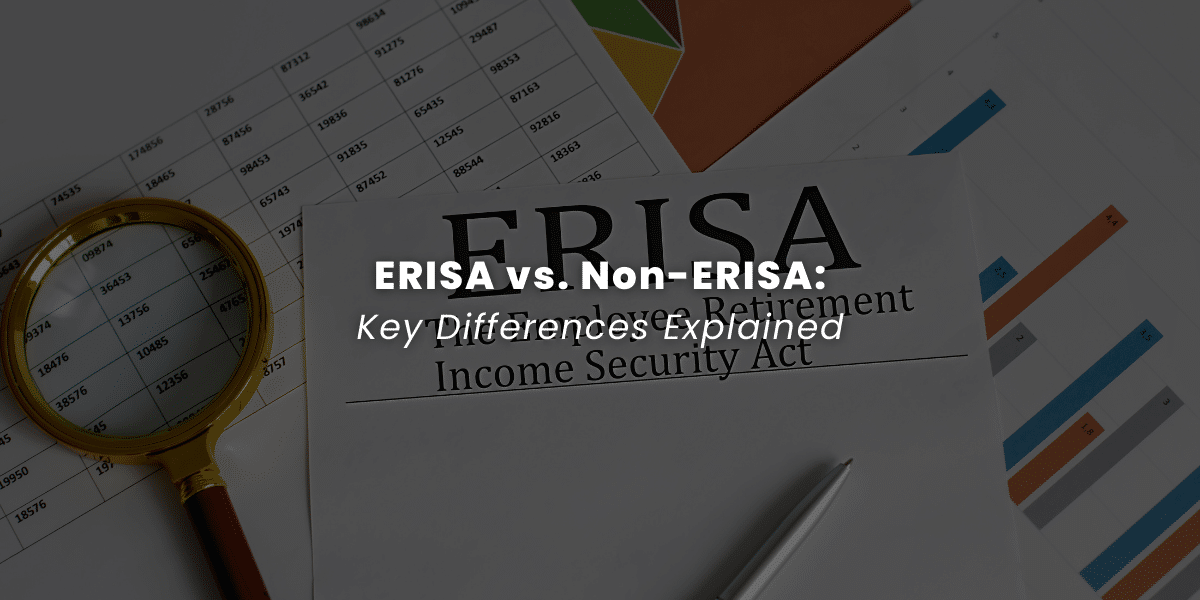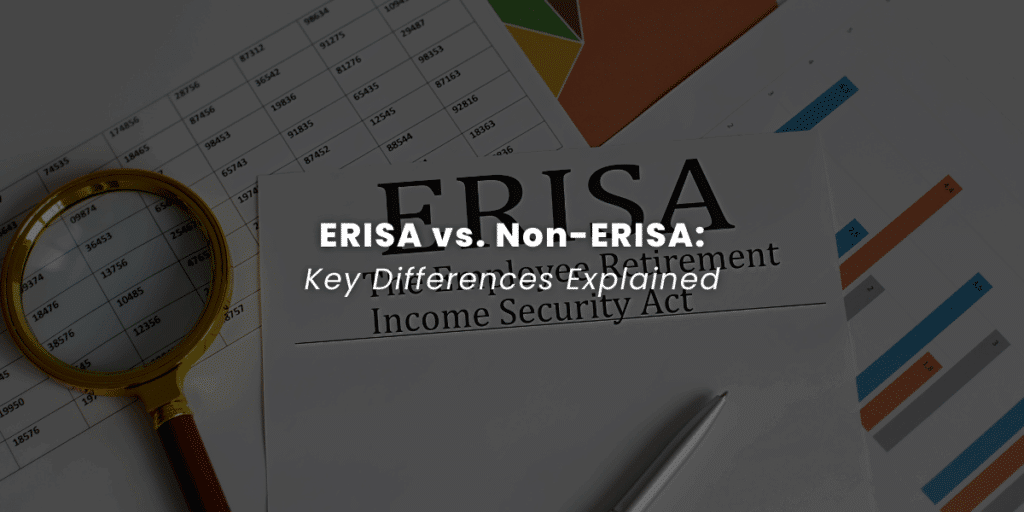Are you trying to understand the difference between ERISA and non ERISA health plans? Whether you’re an employer offering benefits or an employee receiving them, knowing the difference between ERISA and non ERISA plans can significantly impact your healthcare coverage, legal protections, and administrative responsibilities.
As a benefits compliance specialist with over a decade of experience helping organizations navigate the complex world of employee benefits, I’ve seen firsthand how understanding ERISA status affects everything from plan administration to claims disputes.
In this comprehensive guide, you’ll discover the critical differences between ERISA and non-ERISA health and welfare plans, including medical, dental, vision, and life insurance benefits. We’ll explore ERISA vs non ERISA health plans, regulatory frameworks, compliance requirements, and practical implications that affect both employers and employees.
Difference Between ERISA and Non-ERISA
| Aspect | ERISA Plans | Non-ERISA Plans |
|---|---|---|
| Regulatory Framework | Federal law (ERISA) | State laws |
| Common Examples | Most private employer health plans | Government, church, and voluntary plans |
| Fiduciary Responsibility | Strict fiduciary standards | Varies by state law |
| Reporting Requirements | Form 5500, SPD, SMM | Minimal federal requirements |
| Legal Protections | Federal court access, preemption of state laws | State court remedies |
| Plan Administration | Formal documentation required | Less administrative burden |
What Is an ERISA Plan?
The Employee Retirement Income Security Act of 1974 (ERISA) is a federal law that sets minimum standards for most voluntarily established health and welfare benefit plans in private industry. ERISA was designed to protect the interests of employee benefit plan participants and their beneficiaries by:
- Requiring plan sponsors to provide participants with important information about plan features and funding
- Establishing fiduciary responsibilities for those managing plan assets
- Requiring plans to establish grievance and appeals processes
- Giving participants the right to sue for benefits and breaches of fiduciary duty
Types of ERISA Plans
When it comes to health and welfare benefits, ERISA covers a wide range of employer-sponsored plans, including:
- Medical insurance plans
- Dental insurance plans
- Vision insurance plans
- Prescription drug coverage
- Life insurance plans
- Accidental death and dismemberment (AD&D) insurance
- Short-term disability insurance
- Long-term disability insurance
- Health care flexible spending accounts (FSAs)
- Health reimbursement arrangements (HRAs)
- Wellness programs (when medical care is provided)
- Employee assistance programs (EAPs) that provide medical care
- Disease-specific coverage plans
While ERISA also governs retirement plans like 401(k)s and pension plans, our focus here is primarily on health and welfare benefits.
Advantages of ERISA Plans
ERISA plans offer several important advantages for both employers and employees:
- Uniform Administration: Employers with employees in multiple states can maintain a single set of plan rules nationwide.
- Federal Preemption: ERISA generally preempts state laws related to employee benefits, protecting employers from varying state regulations.
- Legal Protections: Claims disputes are typically handled in federal court, which often provides more predictable outcomes than state courts.
- Structured Process: Clear guidelines for claims procedures and appeals processes help ensure fair treatment.
Fiduciary Protection: When followed properly, ERISA’s fiduciary framework can protect plan administrators who act in participants’ best interests.
What Is a Non-ERISA Plan?
Non-ERISA plans are employee benefit plans that are exempt from ERISA regulations. These plans don’t have to comply with ERISA’s strict requirements regarding plan documents, reporting, disclosure, fiduciary standards, and claims procedures.
Examples of Non-ERISA Plans
Several types of health and welfare benefit plans are exempt from ERISA:
- Government Plans: Benefits provided by federal, state, or local government employers to their employees.
- Church Plans: Benefits provided by churches or religious organizations to their employees, unless they elect to be covered by ERISA.
- Plans Maintained Outside the U.S.: Plans primarily for non-resident aliens.
- Voluntary Plans Meeting Safe Harbor Requirements: Certain voluntary insurance programs where:
- Employee participation is completely voluntary
- The program is entirely employee-paid with no employer contributions
- The employer’s involvement is limited to collecting premiums through payroll deductions
- The employer receives no compensation from the insurer beyond reasonable compensation for administrative services
Advantages of Non-ERISA Plans
Non-ERISA plans offer their own set of advantages:
- Reduced Administrative Burden: No requirement to file Form 5500 reports or maintain formal ERISA plan documents.
- Fewer Compliance Concerns: Less exposure to federal penalties for documentation or reporting failures.
- State Law Remedies: Participants may have access to more favorable state law remedies, including compensatory and punitive damages in some cases.
- Simplified Administration: Less stringent requirements for plan communications and disclosures.
Lower Costs: Reduced administrative and compliance costs for plan sponsors.
Relevant Characteristics Between ERISA and Non-ERISA
Regulatory Oversight
| ERISA | Non-ERISA |
|---|---|
| Regulated primarily by the U.S. Department of Labor | Regulated by state insurance departments and other state agencies |
| Subject to federal ERISA standards and enforcement | Subject to varying state insurance laws and regulations |
| Uniform federal standards apply nationwide | Requirements vary by state, potentially creating compliance challenges for multi-state employers |
| DOL has investigation and enforcement authority | State insurance commissioners handle most regulatory oversight |
Preemption of State Laws
| ERISA | Non-ERISA |
|---|---|
| ERISA generally preempts state laws that “relate to” employee benefit plans | No federal preemption; fully subject to state insurance and benefit laws |
| Self-insured ERISA plans are exempt from state insurance mandates | Must comply with all applicable state insurance mandates and benefit requirements |
| Protection from state-specific regulations and mandates | Subject to potentially more consumer-friendly state insurance protections |
| Limits remedies available to plan participants | May allow for broader remedies under state law, including punitive damages |
Fiduciary Responsibilities
| ERISA | Non-ERISA |
|---|---|
| Plan administrators must act solely in the interest of participants and beneficiaries | Fiduciary standards vary by state law; generally less stringent than ERISA |
| Strict “prudent expert” standard of care | Standard of care varies by state; often a “prudent person” standard |
| Personal liability for fiduciary breaches | Liability determined by state law; often more limited |
| Prohibited transactions strictly regulated | Fewer restrictions on transactions with interested parties |
| Required to follow plan documents | Less formal documentation requirements |
Reporting and Disclosure Requirements
| ERISA | Non-ERISA |
|---|---|
| Form 5500 filing required for plans with 100+ participants | No Form 5500 filing requirement |
| Summary Plan Description (SPD) must be provided to participants | No federal SPD requirement |
| Summary of Material Modifications (SMM) required when plan changes | No federal SMM requirement |
| Summary Annual Report (SAR) distribution | No federal SAR requirement |
| Strict timeline for providing plan documents upon request | Document disclosure requirements vary by state |
Eligibility for ERISA Safe Harbor
| ERISA | Non-ERISA |
|---|---|
| Not applicable – these are ERISA plans by definition | Must meet all safe harbor requirements to maintain non-ERISA status: |
| – Employee participation must be completely voluntary | |
| – No employer contributions to the plan | |
| – Employer’s role limited to collecting premiums via payroll deduction and remitting to insurer | |
| – Employer cannot receive compensation from the insurer beyond reasonable compensation for administrative services | |
| – Employer cannot endorse the program |
Enforcement & Legal Risk
| ERISA | Non-ERISA |
|---|---|
| Claims typically heard in federal court | Claims typically heard in state court |
| Remedies generally limited to benefits due and attorney fees | May allow for compensatory and punitive damages under state law |
| No jury trials | Jury trials may be available |
| Exhaustion of administrative remedies required before lawsuit | May allow direct access to courts without administrative appeals |
| Deference often given to plan administrator decisions | Less deference to administrator decisions |
ERISA and Non-ERISA Differences
Beyond the characteristics outlined above, there are several other important differences between ERISA and non-ERISA health and welfare benefit plans. When comparing ERISA vs non-ERISA health plans, these distinctions become particularly important:
Plan Documentation
ERISA plans require formal written plan documents and summary plan descriptions that meet specific federal requirements. These documents must clearly outline plan provisions, claims procedures, and participant rights.
Non-ERISA plans typically rely on insurance policies or certificates of coverage without the additional ERISA-specific documentation. While these documents provide important information, they don’t need to meet ERISA’s detailed content requirements.
Claims Procedures
ERISA establishes strict timelines and procedures for processing benefit claims and appeals:
- Initial claim decisions: 30 days for health claims, 45 days for disability claims
- Appeal decisions: 60 days for health claims, 45 days for disability claims
- Detailed requirements for denial notices
- Independent medical reviews for certain claim denials
Non-ERISA plans follow state insurance law requirements for claims handling, which vary by state but are often less stringent than ERISA’s requirements.
Plan Amendments
ERISA plans must follow specific procedures for plan amendments, including providing participants with a Summary of Material Modifications (SMM) within 210 days after the end of the plan year in which the change was adopted.
Non-ERISA plans can generally be amended according to the terms of the insurance policy or plan document, without the additional ERISA notification requirements.
Penalties for Non-Compliance
- Up to $110 per day for failing to provide requested plan documents
- Up to $2,586 per day for late Form 5500 filings
- Potential fiduciary liability for breaches of duty
Relevant Characteristics Between ERISA and Non-ERISA
Despite their differences, ERISA and non-ERISA health and welfare benefit plans share some important similarities:
- Basic Purpose: Both types of plans aim to provide health and welfare benefits to employees and their dependents.
- Insurance Regulation: Insured plans under both ERISA and non-ERISA frameworks must comply with state insurance laws regarding policy forms, premium rates, and financial solvency.
- Federal Mandates: Both plan types must comply with federal laws such as HIPAA (privacy and portability), the Affordable Care Act (coverage mandates), COBRA (continuation coverage), and MHPAEA (mental health parity).
- Tax Treatment: Benefits provided under both ERISA and non-ERISA plans generally receive similar tax treatment under the Internal Revenue Code.
Participant Communications: Both types of plans must provide participants with information about their benefits, though the specific requirements differ.
Choosing the Right Plan for Your Organization
When deciding between ERISA plans vs non-ERISA plans for health and welfare benefit arrangements, organizations should consider several factors:
For Employers
| Decision Framework: ERISA vs. Non-ERISA Plans | |
|---|---|
| Organization Type | Government entities and churches automatically qualify for exemption from ERISA, though churches can elect to be covered. |
| Administrative Resources | ERISA plans require more extensive documentation and reporting. Consider whether your organization has the resources to manage these requirements or can partner with service providers who can assist. |
| Multi-State Operations | If you have employees in multiple states, an ERISA plan provides the advantage of uniform administration under federal law rather than varying state requirements. |
| Risk Tolerance | ERISA’s limitation on remedies (typically no punitive damages) may provide some protection against large judgments, but the fiduciary responsibilities create their own risks. |
| Benefit Strategy | Consider how your benefits fit into your overall compensation and employee relations strategy. ERISA plans provide a structured framework that some employees may value for its federal protections. |
For Employees
From an employee perspective, the choice between ERISA and non-ERISA plans involves different considerations:
- Claims Disputes: ERISA plans provide a structured appeals process but limit remedies to benefits due and possibly attorney fees. Non-ERISA plans may allow for additional damages under state law.
- Plan Information: ERISA plans must provide detailed plan information through SPDs and other required disclosures, potentially making it easier to understand benefits.
- Fiduciary Protection: ERISA’s fiduciary requirements provide some protection against mismanagement of plan assets and conflicts of interest.
- Legal Venue: ERISA claims are typically heard in federal court without a jury, while non-ERISA claims may be heard in state court with a jury trial option.
Frequently Asked Questions (FAQs)
Are Voluntary Benefits Considered ERISA or Non-ERISA?
When determining what is ERISA or non ERISA for voluntary benefits, the classification depends on specific criteria:
Voluntary benefits can qualify for non-ERISA status if they meet all four requirements of the ERISA safe harbor:
- Participation is completely voluntary
- No employer contributions
- Employer’s role is limited to collecting premiums through payroll deductions
- Employer receives no compensation beyond reasonable administrative fees
If any of these conditions isn’t met—for example, if the employer contributes to the premium or actively endorses the program—the plan becomes subject to ERISA.
How Do ERISA Preemption Rules Affect Non-ERISA Plans?
ERISA preemption doesn’t apply to non-ERISA plans. This means:
- Non-ERISA plans must comply with all applicable state insurance laws and regulations
- Participants in non-ERISA plans can pursue state law remedies that might be preempted for ERISA plans
- Multi-state employers with non-ERISA plans must navigate varying state requirements
Can a Church or Government Plan Be Subject to ERISA?
Church plans are automatically exempt from ERISA but can elect to be covered by filing an election with the IRS and DOL. Once this election is made, it cannot be revoked.
Government plans (federal, state, local) are exempt from ERISA and cannot elect to be covered. They remain subject to applicable state and local laws governing public employee benefits.
Conclusion
Understanding the difference between ERISA and non ERISA health and welfare benefit plans is crucial for both employers and employees. ERISA vs non ERISA is not just a technical distinction—it fundamentally affects how plans operate and what protections are available. ERISA plans offer uniform federal standards, preemption of state laws, and structured processes, but come with significant compliance requirements. Non-ERISA plans provide more flexibility and potentially broader remedies under state law, but lack the uniform protections of federal regulation.
For employers, the choice between ERISA and non-ERISA arrangements depends on organizational type, administrative resources, geographic scope, and risk management strategy. For employees, the differences affect how claims are processed, what remedies are available, and what information must be disclosed.
By understanding these key differences, organizations can make informed decisions about their benefit programs, and employees can better understand their rights and protections under their health and welfare benefit plans.
Whether you’re designing a benefits program or trying to understand your current coverage, the ERISA status of your health and welfare benefits has far-reaching implications that deserve careful consideration.
References
- U.S. Department of Labor. (2024). “ERISA.” Retrieved from https://www.dol.gov/general/topic/health-plans/erisa
- U.S. Department of Labor. (2024). “Fiduciary Responsibilities.” Retrieved from https://www.dol.gov/general/topic/retirement/fiduciaryresp
- Peace Law Firm. (2025, January 15). “ERISA vs. Non-ERISA: How Do You Know?” Retrieved from https://www.peacelawfirm.com/how-do-you-know-erisa-vs-non-erisa/
- BASIC. (2023, May 24). “What Plans Are Governed by ERISA?” Retrieved from https://www.basiconline.com/blog/what-plans-are-governed-by-erisa/
- Windes. (2023, May 30). “ERISA or Non-ERISA Plans?” Retrieved from https://windes.com/erisa-or-non-erisa-plan/
- PeopleKeep. (2023, November 30). “What health plans are and aren’t covered by ERISA.” Retrieved from https://www.peoplekeep.com/blog/what-health-plans-are-covered-by-erisa
- Debofsky Law. (2024, May 6). “Understanding Government and Church Plan Exceptions to ERISA.” Retrieved from https://www.debofsky.com/articles/erisa-exceptions-government-church-plans/
- NASHP. “ERISA Preemption Primer.” Retrieved from https://www.nashp.org/wp-content/uploads/2009/03/ERISA_Primer.pdf
- Mercer. (2022, March 22). “A primer on ERISA’s preemption of state laws.” Retrieved from https://www.mercer.com/insights/law-and-policy/a-primer-on-erisas-preemption-of-state-laws/
- Employee Benefits Security Administration. “Reporting and Disclosure Guide for Employee Benefit Plans.” Retrieved from https://www.dol.gov/sites/default/files/ebsa/about-ebsa/our-activities/resource-center/publications/reporting-and-disclosure-guide-for-employee-benefit-plans.pdf






